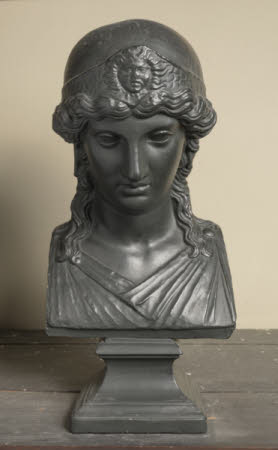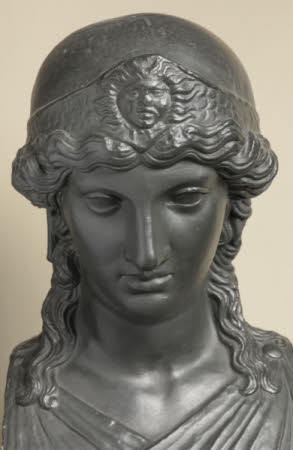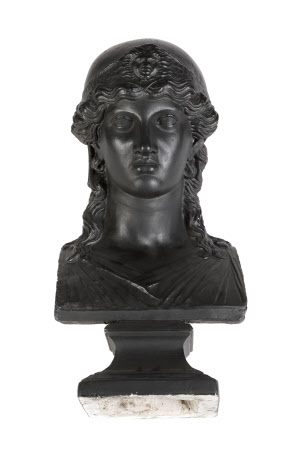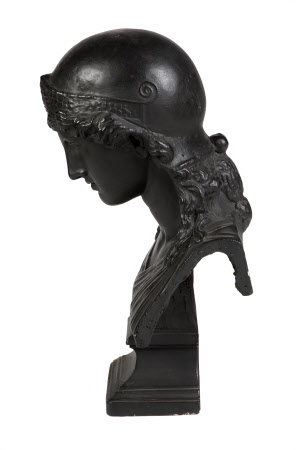Athena
workshop of Matthew Brettingham the Younger (1725 - 1803)
Category
Art / Sculpture
Date
circa 1758
Materials
Bronzed plaster
Measurements
470 x 305 x 275 mm
Place of origin
London
Order this imageCollection
Kedleston Hall, Derbyshire
NT 108988.3
Summary
Bronzed plaster, Athena, after the antique bust in the Capitoline Museum (formerly in the collection of Cardinal Albani), probably cast in London, possibly by Bartolomeo Mattevali, on behalf of Matthew Brettingham (1725-1803), c.1758. A bust of the Greek goddess Athena, wearing a chiton fastened at the shoulders with fibulae, and a helmet embellished with a gorgoneion. One of set of seven plaster portrait busts depicting Greek and Roman philosophers, writers, gods and goddesses, each cast from moulds after antique busts in Roman collections. Painted to look like bronze, mounted on a socle atop the bookshelves in the Library of Kedleston Hall.This cast is after an early Imperial herm in the Capitoline Museum which was transferred from Cardinal Albani’s collection in 1733.
Full description
During his seven-year stint in Rome (1747-54) Matthew Brettingham not only dealt in casts and antiquities - furnishing the Earl of Leicester, for example, with casts and marble statues for Holkham Hall - but also commissioned actual moulds to be taken from famous Roman antiquities. The idea was that casts could then be made to order when he returned to London. He commissioned moulds for sixty busts, divided between Greek and Roman subjects, and twelve moulds of full-size statues. In addition to the 10 casts of statues he purchased for the Marble Hall, Nathaniel Curzon, 1st Baron Scarsdale (1826-1804), bought many of the classical busts on Brettingham’s books. Seven are mounted on top of the bookcases (NT 108611) in the Library of Kedleston Hall, in a display related to Robert Adam’s proposed designs for the room (see NT 109438–109442).The busts depict: the Greek philosopher Socrates; Homer, the legendary Greek author of the Iliad and Odyssey; the Greek goddess Athena; a Vestal Virgin of Rome; the Greek poets Pindar and Sappho; and Dionysus, Greek god of wine and revelry.Brettingham's Rome Account Book, his ledger of statues dealt, casts made, bought and sold when he was in Italy, confirms that the Library busts were moulded from some of the most prestigious antiquarian collections in Rome. ‘Athena’ and ‘Pindar’ come from the Capitoline Museums, the world’s first public museum owned by the municipality of Rome (Kenworthy-Browne 1983, pp. 73, 74, 94). According to Brettingham’s records a mould was taken of the Capitoline herm of Athena in January 1753, although it was then considered a ‘Testa Incognita’ thought to depict Aspasia, the intellectual and mistress of Pericles. That attribution was published in ‘Il Museo Capitolino’, a catalogue of works by the Vatican librarian Giovanni Bottari (Bottari 1819, vo. I, pp. 131-2). The herm has since been called Athena. A receipted bill, dated 23 January 1758, exists in the Kedleston Archive for five of the busts: ‘the Farnesian Homer’ for which Brettingham charged Lord Scarsdale £2-0s-0d (just over £200 in today’s money) and the ‘Vestal Virgin’, ‘Pindar’, ‘Socrates’ and ‘Plato’ (i.e. Dionysus) all charged at £1-10s-0d (just over £150). The other two (Athena and Sappho) certainly came from Brettingham, although no bill or receipt exists to prove a transaction. The bust is listed in Nathaniel Curzon’s handwritten ‘List of Statues I have’ (c. 1760; MS, Kedleston Archive) as 'Aspatia', i.e. Aspasia. It was later erroneously listed as 'Virgil' in the published 1769 'Catalogue of the pictures, statues, &c. at Kedleston’ (p. 13). Alice Rylance-WatsonMarch 2019
Provenance
Purchased by Nathaniel Curzon, 1st Baron Scarsdale (17126-1804) in c. 1758; see receipted bill dated 23 January 1758 for five of the busts (Homer, Vestal Virgin, Pindar, Socrates and Plato (i.e. Dionysus), each bust at £1-10-0 (MS, Kedleston Archive); identifiable, although with some incorrect titles, in the 1769 'Catalogue of the pictures, statues, &c. at Kedleston' (p. 13) as 'Busts of Homer, Sappho, Socrates, Virgil (incorrect), Anacreon (incorrect), Pindar, Horace (incorrect); identifiable in the 1861 'Catalogue' (p. 13), the busts listed as exactly as they were in 1769; purchased with part of the contents of Kedleston Hall with the aid of the National Heritage Memorial Fund in 1986 when the house and park were given to the National Trust by Francis Curzon, 3rd Viscount Scarsdale (1924-2000).
Credit line
Kedleston Hall, The Scarsdale Collection (acquired with the help of the National Heritage Memorial Fund and transferred to The National Trust in 1987)
Makers and roles
workshop of Matthew Brettingham the Younger (1725 - 1803), dealer possibly Bartolomeo Mattevali, caster
References
Kenworthy-Browne 1983: John Kenworthy-Browne, 'Matthew Brettingham's Rome Account Book 1747-1754', The Volume of the Walpole Society, vol.49 (1983), pp.37-132 Kenworthy-Browne 1993: John Kenworthy-Browne, ‘Designing around the statues. Matthew Brettingham’s casts at Kedleston’, Apollo, April 1993, pp.248-252



